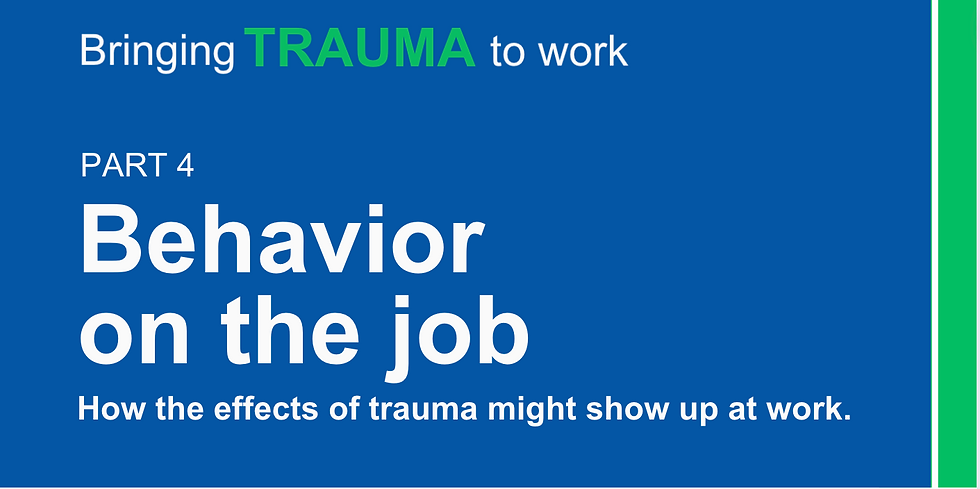Part 3: How the brain changes
- glennakleiman
- Oct 9, 2023
- 4 min read
Updated: Nov 14, 2023

Download the guide:
Prefer to listen? Check out our podcast of Part 3 here.
Picture your mind acting as an air traffic control radar system -- constantly sweeping around your environment, making sure everything is safe.
As you continue to watch the screen, green lights begin to blink, signaling danger. First, a few. Then more. Adrenaline rushes through your body. Your heart pounds, pulse quickens, muscles tense, forehead sweats. You’re afraid.
Now imagine that’s how you feel often – or always.
That’s the reality for many survivors of trauma.
Their difficulties might start with a traumatic event or events. But even when the radar screen clears -- the threats have passed – a heightened sense of danger often remains.
Why? What does trauma do to the brain? By understanding the basic science, you will better understand what some of your workers are experiencing.
ALARM SOUNDS
When any of us feel in danger an “alarm” goes off in our brains, triggering a “fight, flight, or freeze” response.

That alarm lives in our amygdala, the “survival” mechanism of our brain. It releases a surge of hormones and sends blood and oxygen to our muscles, enabling us to react quickly.

For your employees who have experienced trauma, especially repeatedly, this alarm doesn’t turn off.
Terri deRoon-Cassini, MS, PhD, of the Medical College of Wisconsin, equates it to an alarm system for the White House.
“It's like 24/7, 360 degrees surveillance," she says. "It picks up on things that previously you would not have perceived as threatening. Then you have people whose baseline anxiety is higher, and it's going up from there because it's detecting a lot more things as threatening.”
NO BRAKES
Once real threats have passed, our brains are supposed to put the brakes on our “fight, flight or freeze” responses.

That’s the job of the prefrontal cortex, the “thinking” part of the brain, where rational thought and executive functions like problem solving take place. It’s supposed to tell us ‘It’s okay, you’re safe now.’
But toxic stress essentially turns off that function. Our primitive, emotional response remains strong. In other words, “fear shuts down thinking and amps up feeling.”
Tim Grove, senior director of trauma-informed strategy and practice at Wellpoint Care Network, says this is key for employers to understand.
"When I'm in survival mode, by definition, the best part of my humanity shuts down, and the more primitive parts of my humanity kick in,” Grove says.
Not only can trauma make the brain function differently, it also can change the structure of the brain itself. Because the amygdala – the “alarm system” – is activated so often, it grows. The prefrontal cortex, the part of the brain that’s supposed to “cool off” the amygdala (but doesn’t) shrinks.
DANGEROUS 'NEW NORMAL'
The result: the stress response remains activated, much like a motor idling too high for too long.
This becomes the new normal -- with dangerous consequences. Living in a constant state of high alert can have devastating effects on your physical and emotional health.
"... increases risk for other health problems."
Terri deRoon-Cassini, MS, PhD Medical College of Wisconsin
When you’re hypervigilant on a regular basis, the hormones you release can damage blood vessels and arteries, increasing blood pressure and raising the risk of heart attacks or strokes.
Fat tissue can build up, creating weight gain and increasing the likelihood of type 2 diabetes.
Your immune system can wear down, making you more susceptible to illnesses, and can even make you age faster.
“Individuals under chronic stress, particularly individuals under not just individual chronic stress, but neighborhood-related chronic stress, it actually can accelerate the age of cells in the body," deRoon-Cassini says. "And if you think about, it makes sense. If your body is responding as stressed, then it's really causing wear and tear on the body.”
Chronic stress also impacts mental health, often leading to anxiety and depression, as we learned from Kenneth Barron in the previous section.
And, in an attempt to calm the hyper-aroused body and mind, a trauma survivor may turn to drugs and alcohol.
“I believe that many people who struggle with drug and alcohol abuse are actually trying to self-medicate due to their developmental histories of adversity and trauma,” says Bruce D. Perry, MD, PhD, in the book "What Happened to You?" which he co-authored with Oprah Winfrey.
Topitzes explains where that can lead.
“Whether that's marijuana or alcohol or whatever, it really helps me overcome that agitated or activated feeling," he says. "And there's a slippery slope there. I might end up using as a pattern of behavior. If I use a substance I'm going to feel better. So then I start to use a substance every time I feel agitated.”
NEUROPLASTICITY
The good news? A traumatized brain can recover.
The brain is malleable, a principle called “neuroplasticity.” Just as the brain adapts when traumatized, it also can adapt when stimulated in a healthier way.
“When you treat the symptoms of PTSD," says deRoon-Cassini, "the brain changes both in structure and volume as well as functioning. It looks like a brain that is less chronically stressed, and therefore has better ability to regulate emotion, discern what is threatening and what isn't, and having a natural response, rather than muddling along in this dysregulation.”
The workplace can help. By providing an environment in which employees feel safe and supported, you can aid in re-establishing healthy, optimized brain function – and, as a result, get more productive, reliable workers.




Comments